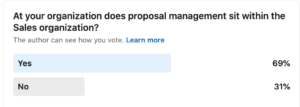RFPs are part of the sales cycle. Ergo, RFP teams should be part of the sales team. You’d think it would be that simple… but, alas, nothing in the world of proposals is simple.
I’ve been in the proposal industry for almost two decades. Throughout that time, I’ve had to “make my case” to prove why I deserved a spot at the sales table. This is despite the fact that $11 trillion of revenue is won through competitive proposal processes every year—and organizations with proposal professionals submit 3x more RFPs than those without.
And I know I’m not alone. According to a recent LinkedIn poll we conducted, only 69% of respondents said proposal management sits within the sales organization.

For proposal managers who want to prove their value and drive sales productivity, the first step is demonstrating how your role fits in with the sales cycle.
Put an end to RFP telephone
Oftentimes, the RFP handoff from sales looks something like this:
- Sales forwards an RFP to the proposal manager and tries to get the proposal manager up to speed on the last 8 months of activities in about 15 minutes.
- The proposal manager starts herding the cats of SMEs and leadership in a short amount of time.
- Because the proposal manager wasn’t fully part of the sales strategy from the get-go, they aren’t able to answer questions about proposal strategy from SMEs.
- If the SMEs want to know what kind of “spin” they should put on certain questions, proposal managers might not know if they didn’t have a good hand-off from sales.
As a result, the SME answers the question generically and the proposal won’t be tailored to the customer’s specific needs. SMEs feel like they’ve wasted their time, proposal managers feel unequipped, and sales might lose the deal.
That’s why proposal managers need to be involved in sales conversations from the very beginning.
If you’re trying to get caught up on everything, it’s too much to take in a short amount of time. You need to understand how sales has been building up to that proposal, and what you need to highlight in the proposal to make sure you’re putting your best foot forward.
Take your seat at the sales table.
The most important thing you can do to prove that you’re part of the sales team is act like you’re part of the sales team.
That means making it clear to your sales leader that you need a better understanding of what’s coming down the line and need to be part of sales huddles and pipeline meetings. This is especially important in this new era of remote work, where we’re not running into each other at the office. In the absence of impromptu conversations, we (proposal professionals) need to be more purposeful about communicating with sales.
If you’re not currently part of sales huddles and pipeline meetings, here’s an email template you can borrow to request to be part of those meetings:
Hi {boss name},
I’m writing to request an invitation to the sales team’s weekly sales huddles and pipeline meetings.
As the proposal manager, I’m responsible for crafting a compelling proposal that solves our clients’ problems. The sooner I’m clued into the status of open opportunities, the sooner I can start researching our client—and the more compelling proposal I can write.
To put a number on this:
- Total dollar value of proposals won in [last year]:
- Total dollar value of proposals lost in [last year]:
By joining sales conversations early on, I’m confident I can increase our proposal win rate—and help push deals deeper into the sales cycle.
Looking forward to seeing you in the first meeting!
Best,
{Your Name}
Take this template and make it your own—especially the metric purpose. I recommend tailoring your impact data to your company’s sales goals, whether that be revenue, membership, or new logos signed. Once you’re part of those meetings, you have a chance to bring up ideas and offer your help. And help people understand that proposal teams don’t exist just to respond to RFPs. They are critical to winning and retaining accounts.
Gimme the data
After you’ve made the case to rightfully take your spot on the sales team, the next step is proving to leadership what you’re bringing to the table. And, more importantly, what would happen if you weren’t there.
This leads me to my golden rule of proposal management: Even if you think everyone knows how much you’re working, they don’t.
If you’ve ever been told something along the lines of “Wow, your team is magic!”, that’s a big red flag. My team is full of amazing, competent human beings who are excellent at their jobs. But there’s no such thing as magic. And if everyone else at your company believes you’re a team of magical proposal elves, that’s an easy recipe for burnout. If you find yourself in that situation, you need to demonstrate how much time you’re spending on projects.
Here’s a list of everything you need to track to start building your case:
- Number of questions in each RFP
- Time spent
- By RFP
- By task (e.g. formatting, printing, coordinating with SMEs)
- By team member
- Number of RFPs and due dates
If you’re thinking, “I don’t have time to track all this”… Well, that’s probably a sign that you need to start tracking these metrics and prove to leadership how much you’re working. If you have RFP software, tracking these metrics is easy. If you don’t, it’s a bit more challenging, but not impossible. I’ll cover both methods in the next two sections.
I think there’s an app for that…
If you really want to get on top of your data tracking, RFP software is going to be extremely helpful. It tracks all those metrics I listed in the previous section automatically, so you can just get on with your normal business and pull a report at the end of the quarter (or month or year or whatever it may be).
At my previous employer, we used RFPIO. We just went about our normal business and let RFPIO whir in the background. At the end of our analysis, we created a report showing (in quarterly timeframes and YTD):
- How many hours go into each RFP
- How many hours each individual is working per week
- How many hours are spent on each part of the RFP
And the results of my report were really eye-opening for senior staff. I was able to prove that we needed an extra 2.5 people to achieve the same output and work 8 hours per day. As a result, we were put at the top of the list for new hires over the entire sales organization.
In lieu of RFP software, pivot tables are your friend
If you aren’t using RFP software, you’ll need to say hello to pivot tables, because they are going to be your new best friend.
First, ask your team members to use a free time-tracking software (like Toggl) to track their time. If you’re anything like me, you hate asking your over-worked team to do extra work. If you start thinking that, just remember: The only way you can help your team get the support they need is by proving to the rest of the organization how much work you and your team are actually doing.
To put together a comprehensive report, you’ll need to ask your team members to track time by:
- RFP, and
- Task (e.g. formatting, printing, coordinating with SMEs, etc.)
At the end of the week, compile the report from each of your team members and pivot table away.
You don’t have to do this exercise forever. Only as long as it takes to build your case. Maybe it’s a week, maybe it’s a month. But just know that at the end of the exercise, you’ll have the data you need to prove how much you’re working.
Because—and I can’t say this enough—nobody knows how hard you work. And after you show them the numbers, they’ll wonder how you were ever able to do it all.
Building the right tech stack for your proposal team
As a proposal manager, you probably won’t have a huge say in what tech your team uses. When my previous company switched from Skype to Teams, nobody asked me what my thoughts were. All I could do was adjust and adapt.
And here is my pitch for RFP software. It truly is a game-changer for proposal teams. If you (or your boss) still need convincing, here are all the stats you need to build your case.
With RFP software, you can:
- Act on the 80/20 rule: Automate responses to standard questions, and spend more time personalizing the client-specific questions
- Always use the right client names: With RFP software, you can merge tags like [client name] making sure you never accidentally use the wrong client in a proposal (an easy mistake, but still embarrassing)
- Consolidate content, and keep it up to date: With an AI-enabled content library, you can store pre-approved, proposal team-blessed content, and make sure your entire sales team has access.
If you are already using RFP software, find ways to integrate with the rest of your tech stack. For example, RFPIO (my personal favorite RFP software) integrates with all kinds of platforms, including:
- CRMs (Salesforce, MS Dynamics, Hubspot)
- Cloud Storage (Box, Dropbox, Sharepoint, OneDrive, Google Drive)
- Communication Apps (Slack, MS Teams, Google Hangouts, Jira)
- SSO Authentication (Azure, Okta, OneLogin)
- Web Browsers (Google Chrome, Chromium Edge) (These are technically called “browser extensions” and not “integrations” but whatever)
- Microsoft Office (Excel, Word, PowerPoint, Outlook)
Proposal managers are essential to driving sales productivity
Trillions of dollars of revenue are won through competitive proposal processes each year, and organizations with dedicated proposal managers submitted 3.5x more responses in 2020 than those without.
To learn what else proposal managers can to do drive sales productivity, check out our newly published white paper: Experience the Freedom to Thrive. One thing we found… with the right sales stack, proposal managers become an impactful source of revenue.
Not to toot our own horn, but with RFPIO, you can expect to reduce your RFP response time by 40% (on average). To put a number on that: If you spend 40 hours per week responding to RFPs, RFPIO could save you 16 hours per week, on average.
Ready to see how it works? Schedule a demo.
This blog was originally published on the RFPIO blog. Read it here.



Join the Conversation